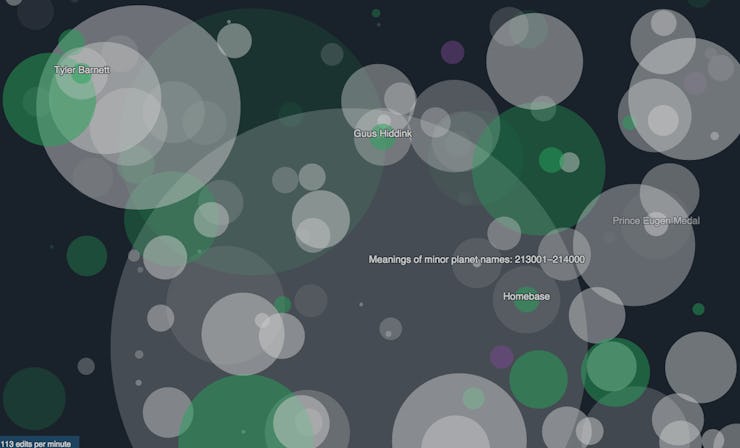'Listen To Wikipedia' Turns Wikipedia Edits Into Ambient Music
Move over, Brian Eno.

My new favorite band is Wikipedia.
Humanity’s ever-evolving store of knowledge has been rendered as dreamy ambient music with a rather brilliant project called Listen to Wikipedia. The site’s server runs software that monitors the whole of Wikipedia for any changes — additions, deletions, even new users — and uses each event to trigger musical events.
Take a second to listen to this dreamy symphony:
Here are those sounds explained: Bell sounds signify additions to an article, string plucks designate deletions, and every time a new user registers for Wikipedia, listeners are treated to a swell of orchestra strings. The sounds are rather disparate on their own, but in concert (and with help of noise-canceling headphones), this listener can’t help but be transported.
Listen to Wikipedia is a piece of open source software created by former college classmates Stephen LaPorte and Mahmoud Hashemi. The pair met at a Wikipedia hackathon and started Hatnote, a site that features all order of Wikipedia-related information: data visualizations, interactive maps, even a program that will email you the most-edited Wikipedia article of the week.
LaPorte presently works as legal counsel for the Wikimedia Foundation and Hashemi is a developer at PayPal. Hashemi told KQED News that the Listen to Wikipedia project was a welcome distraction from San Francisco tech culture; there’s no money to be made by turning Wikipedia into music, it’s a creative programming practice for its own sake.
You can listen to English Wikipedia edits, or for a more-developed sound you can listen to a bunch of major-language edits all at once. You might also want to take the free Listen to Wikipedia iOS app for a spin.
Whether you give yourself a minute to experience this worthwhile oddity or an hour to immerse yourself in a blissed-out soundscape, it’s only possible because people are perpetually tweaking the internet’s free encyclopedia. Hashemi and LaPorte just wrote the code to harness it.